Author:HB Nonwoven MachineryFROM:Compressed Towel Machine Manufacturer TIME:2023-11-13
Installation Guide for Non-woven Roll Slitting Machine

The non-woven roll slitting machine plays a crucial role in the hygiene products industry, specifically in the production of diapers and sanitary napkins. This guide aims to provide step-by-step instructions for the installation of the machine, ensuring smooth and efficient operation.

Prior to installation, it is essential to ensure that all necessary tools and equipment are available. These may include wrenches, screwdrivers, lifting machinery, and safety gear. Additionally, the designated installation area should be clean, well-lit, and have sufficient space to accommodate the machine and its components.

Begin by unpacking the non-woven roll slitting machine and carefully inspecting all components. Verify that all items are present and undamaged. Any discrepancies or damages should be reported immediately to the supplier or manufacturer.
Create a strong and stable foundation for the machine by leveling the installation area and ensuring appropriate flooring. Use leveling devices, such as spirit levels, to ensure accuracy. It is crucial to provide sufficient support to withstand the weight and vibrations generated during operation.
Place the non-woven roll slitting machine in the desired position, ensuring that it is aligned correctly with other machines if applicable. Adjust the machine's position to allow easy access for operators and maintenance personnel. Take into consideration the flow of materials and workflow within the production line.
Connect the machine to the power supply according to the manufacturer's instructions. Ensure that proper safety measures are followed, such as grounding the electrical connections. Connect pneumatic hoses securely, paying attention to any specific requirements outlined in the machine's documentation.
Install the slitting blades and rollers as per the machine's specifications. Ensure that they are securely attached and aligned properly to achieve accurate cuts. Follow any guidelines provided by the manufacturer regarding adjustments or settings for different types of non-woven materials.
Before commencing full-scale production, conduct thorough testing and calibration of the non-woven roll slitting machine. Verify that all components are functioning correctly, and make any necessary adjustments. Ensure that the machine is operating at the desired speed, tension, and cutting precision.
Once the installation and testing processes are complete, provide training to the operators and maintenance personnel. Familiarize them with the machine's features, controls, and safety protocols. Only after comprehensive training should the machine be commissioned for use in production.
The successful installation of a non-woven roll slitting machine is crucial for the efficient production of diapers and sanitary napkins. By following this guide, manufacturers can ensure a smooth installation process, resulting in a reliable and productive machine that meets the industry's demands.





